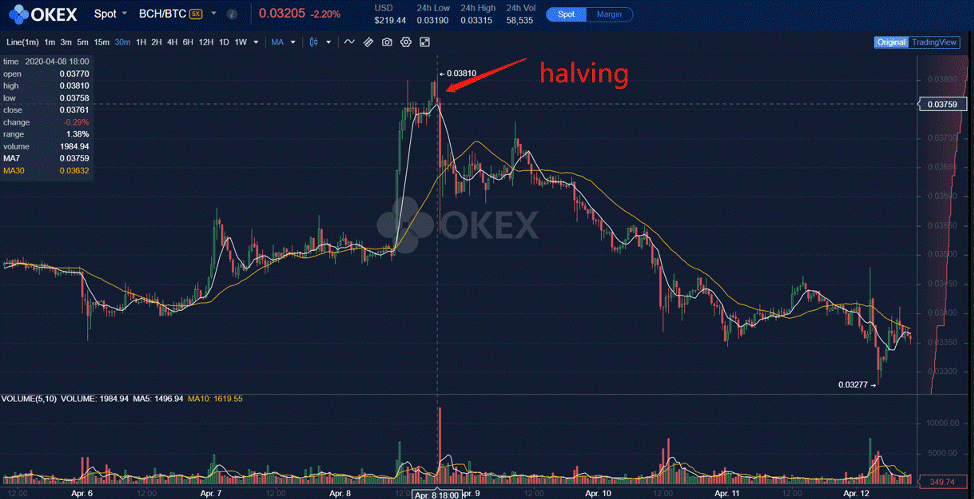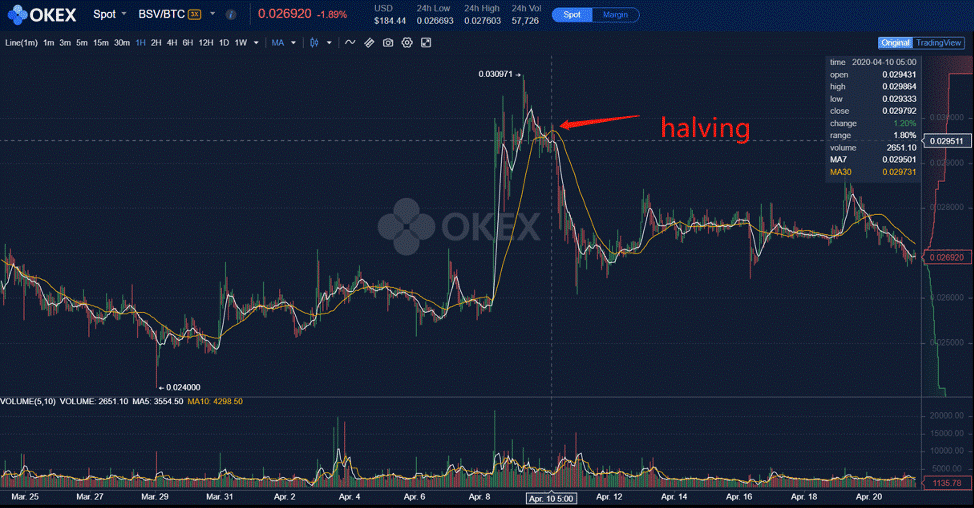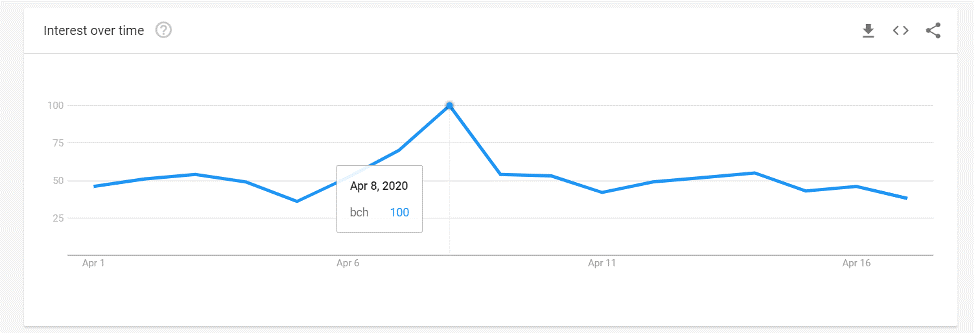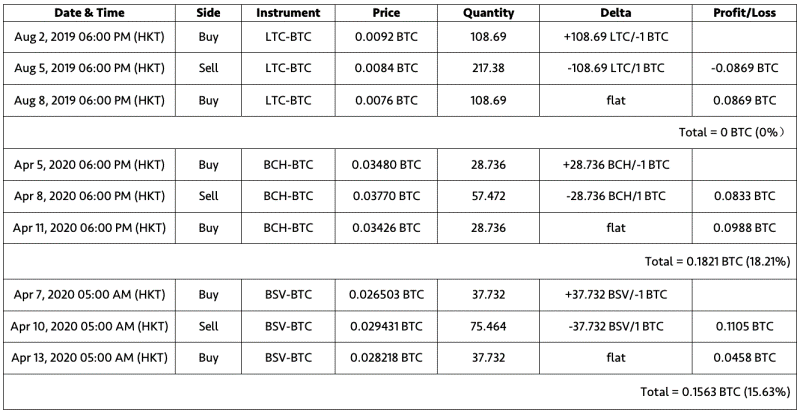With the next Bitcoin halving expected to happen under a month (May 12, 2020), a significant number of users believe that this will create a bullish run for BTC as halving decreases its inflation. In this article, we’ll use historical data to explore how to trade halvings from an events arbitrage perspective.
Looking at historical data
In April 2020, we experienced halvings for both Bitcoin Cash (BCH) and Bitcoin SV (BSV) on Apr 8 and Apr 10 respectively. Let’s look at their price graphs against BTC only so as to remove the noise created by market movements:
We can observe that the price peaks on the halving date. As a quantitative trader, I believe the price of assets in the short-term is driven by supply and demand. The fundamental aspect of decreased inflation that causes price increase can be ignored in the short-term. We can imagine that the price is at the highest point when the market is sentiment is high due to all the news surrounding the halving. Take a look at the Google Trend screenshots below. It shows that the search for BCH and BSV peaked right at the time of halving, meaning demand is at its highest. Therefore, in theory, we can buy the rumor and sell the news.
Backtesting the Long Short Strategy
We can see that the Google Trend usually begins to rise about 3 days before halving, peaks on the halving date, and then goes down after halving. Using the past halving data of LTC (halved on Aug 5, 2019), BCH and BSV, we can propose a simple trade to long before halving, short on the halving date, and unwind the final position 3 days after halving.
We can perform 3 trades against the BTC quote pair to remove noise from the market: Buy ~1 BTC of the halving coin 3 days prior to halving, short ~1 BTC on the halving date, then unwind 3 days after halving to net a total of 33.84% return, with an average 11.28% return on each trade.
Example:
The total return will be around 0.3384 BTC (33.84%), with an average return of 11.28%.
How to trade the upcoming BTC halving
This simple back test shows that there is alpha when you “buy rumor, sell news” for small-cap coins. However, applying this to trade BTC is different and there is no easy way to hedge the market. In the examples above, we are essentially delta flat as we are constantly buying or selling BTC against the halving coin. But for a similar BTC trade, we need to either take delta by trading it against USD or USDT with OKEx Margin Lending or USDT swap; or alternatively hedge it with ETH. It will be up to traders themselves to determine which is the best cause of action.
Conclusion
Today we looked at an event arbitrage trading strategy to long a halving coin before halving and then short it right after halving. To summarize, the theory behind is that due to the heated discussion and news on halving, the demand for that coin will increase prior to the event; but as the news die down after it halves, the buying pressure is gone and the coin price would drop. We’ve backtested the strategy on 3 coins against BTC to remain delta neutral. It is now up to traders to decide whether we apply this trading logic to the upcoming BTC halving in May.
Halving dates for different coins:
This material should not be taken as the basis for making investment decisions, nor be construed as a recommendation to engage in investment transactions. Trading digital assets involves significant risk and can result in the loss of your invested capital. You should ensure that you fully understand the risk involved and take into consideration your level of experience, investment objectives and seek independent financial advice if necessary.
Editors’ Picks

AUD/USD recovers further to 0.6000 despite escalating US-China trade war
AUD/USD is building on its recovery from its lowest level since March 2020, retesting 0.6000 in Wednesday's Asian trading. The pair's upside appears elusive as officials confirmed that the US will proceed with a sweeping 104% tariff on Chinese imports starting this Wednesday.
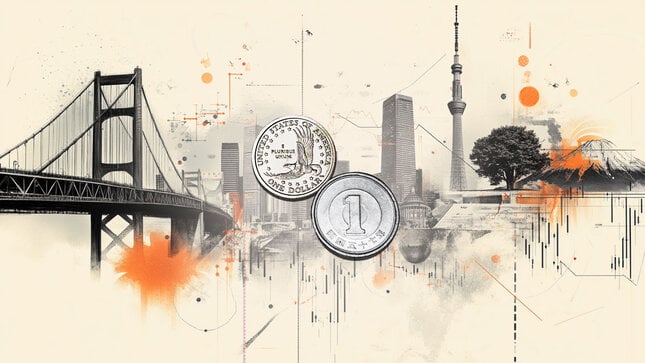
USD/JPY: Japanese Yen strengthens further as recession fears boost safe-haven demand
The Japanese Yen continues to benefit from US tariffs-inspired global flight to safety. Hopes for a US-Japan trade deal further underpin the JPY amid sustained USD selling. The divergent BoJ-Fed expectations support prospects for deeper USD/JPY losses.

Gold price extends its consolidative price move near multi-week low
Gold price remains confined in a range near a multi-week low touched on Monday amid mixed fundamental cues. The widening global trade war and recession fears lead to an extended sell-off in equity markets worldwide. Moreover, bets for more aggressive Fed rate cuts and a weaker USD act as a tailwind for the bullion.

Bitcoin, Ethereum and Ripple target $73,000 BTC, $1,300 ETH, and $1.30 XRP
Bitcoin price hovers around $76,200 on Wednesday after falling 3.59% the previous day. Ethereum and Ripple followed BTC’s footsteps and continued their downward trend.

The Fed is looking at a hefty price level
We are still in thrall to tariffs, the faux-macro “data” driving markets. The WSJ editorial board advised other countries to take their tariffs to zero so that Trump’s “reciprocal” tariffs will have to be zero, too. Cute, but no cigar.
RECOMMENDED LESSONS
Making money in forex is easy if you know how the bankers trade!
Discover how to make money in forex is easy if you know how the bankers trade!
5 Forex News Events You Need To Know
In the fast moving world of currency markets, it is extremely important for new traders to know the list of important forex news...
Top 10 Chart Patterns Every Trader Should Know
Chart patterns are one of the most effective trading tools for a trader. They are pure price-action, and form on the basis of underlying buying and...
7 Ways to Avoid Forex Scams
The forex industry is recently seeing more and more scams. Here are 7 ways to avoid losing your money in such scams: Forex scams are becoming frequent. Michael Greenberg reports on luxurious expenses, including a submarine bought from the money taken from forex traders. Here’s another report of a forex fraud. So, how can we avoid falling in such forex scams?
What Are the 10 Fatal Mistakes Traders Make
Trading is exciting. Trading is hard. Trading is extremely hard. Some say that it takes more than 10,000 hours to master. Others believe that trading is the way to quick riches. They might be both wrong. What is important to know that no matter how experienced you are, mistakes will be part of the trading process.

The Best brokers to trade EUR/USD
SPONSORED Discover the top brokers for trading EUR/USD in 2025. Our list features brokers with competitive spreads, fast execution, and powerful platforms. Whether you're a beginner or an expert, find the right partner to navigate the dynamic Forex market.
